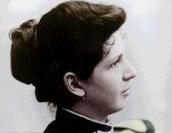
By the late 1840's, economic depression swept the United States, and Louis Metoyer's fortunes shifted dramatically, causing him to lose the plantation. Brothers Henry and Hypolite Hertzog, whose family owned the nearby Magnolia Plantation, purchased Melrose Plantation and ran it for the next 35 years.
In 1881, the Hertzog family sold Melrose Plantation at a public auction. It was purchased by Francis Roman Cauranneau of New Orleans for $1,500, but sold three years later to Joseph Henry. When Joseph Henry passed away in 1899, his son and daughter-in-law, John Hampton Henry and Carmelite Garrett Henry bought the property from their heirs, ushering in one of the most extraordinary periods in the plantation's history.
Carmelite Garrett Henry, or "Miss Cammie", embraced the remarkable history of the home and saw the site as a place to build an even more auspicious history. Miss Cammie restored the run-down buildings and replanted the extensive gardens on the grounds. She oversaw the addition of numerous trees and plants from other parts of Louisiana and created a showcase of flowers that included irises, lilies, and roses, as well as the addition of twin hexagonal wings on either end of the house.
As significant as the plantation's makeover was, however, it was Miss Cammie's decision to refit buildings on the property into living spaces for visiting artists that transformed the site from a quiet country estate to a center for creativity.
Over time, Melrose hosted well-known writers of the early 20th-century including Rachel Field, Ada Jack Carver, and Lyle Saxon. It was at Melrose that Saxon wrote his best known novel, Children of Strangers, which portrays the Cane River area. Artists, photographers, naturalists, illustrators, architects, historians, and celebrities of the era complete the mix of creative talent that paused for days or weeks at the plantation. One guest, Francois Mignon, arrived for a six-week visit in the early 1940's and stayed 32 years. Mignon became a central character both during Miss Cammie's lifetime and during his continued residency after her death in 1948 until he moved from Melrose in 1970.













